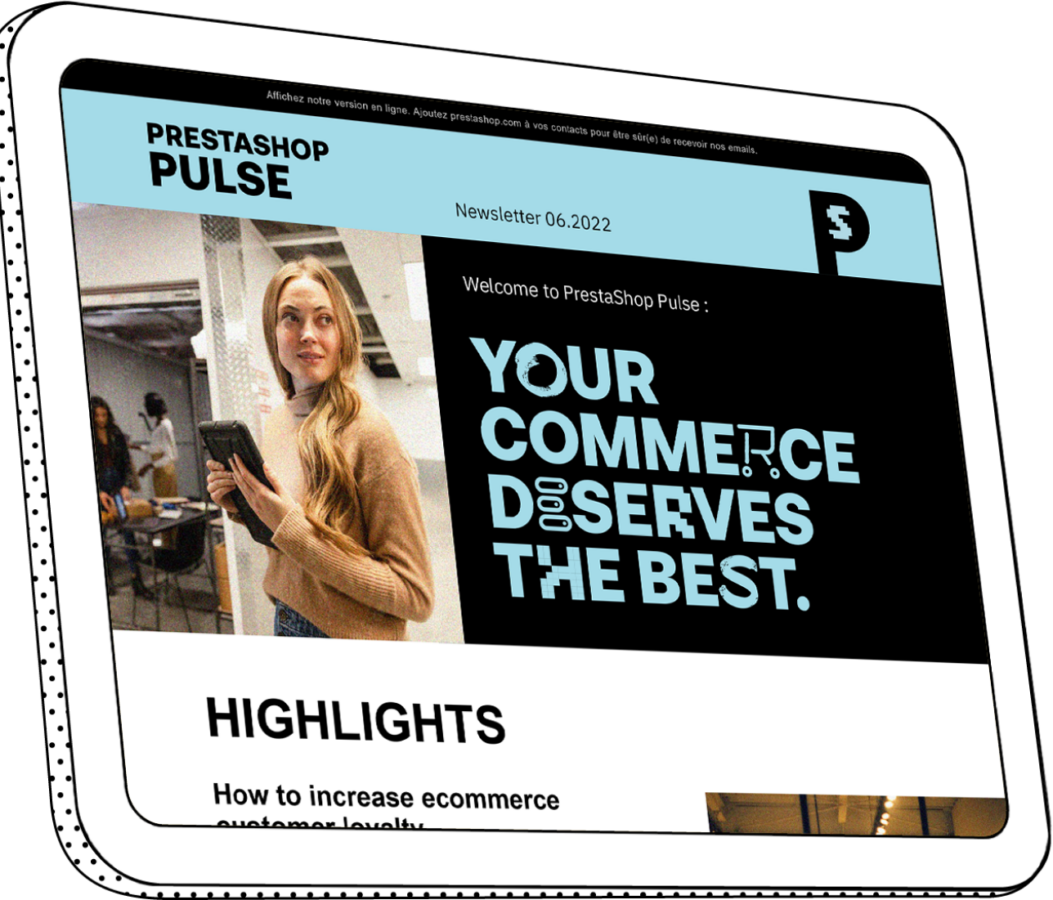Infographic: 10 key ecommerce trends to follow in 2022
The global pandemic has allowed ecommerce to make spectacular developments. Many consumers have definitely changed their purchasing behavior and are already making new demands. In response, ever more attractive and innovative services have emerged in the market. Cohort targeting, live shopping; visual commerce will certainly add to omnichannel commerce while new acronyms (BNPL, PUDO, DTC...) will become common language as of 2022.
1. Omnichannel
Since the health crisis, the omnichannel approach has become central to the business models of companies of all sizes and in all sectors. With the development of click & collect (+600% between 2019 and 2020), it has proven to be one of the main drivers of revenue growth with an estimated rate of 9.5%, compared to 3.4% for companies with weak omnichannel strategies.
As Alexandre Eruimy, CEO of PrestaShop, pointed out at the PrestaShop Day 2021
This is a real breakthrough: digital finally has its place! In the future, we will no longer talk about ecommerce on the one hand and physical commerce on the other, but rather about commerce itself.
This new reality goes hand in hand with new consumer expectations. In 2019, 87% of customers said they wanted a personalized and consistent experience across all shopping channels. This desire for a "seamless" journey does not only concern electronic devices (desktop, tablet, smartphone, connected watch...). It involves all points of contact with the brand, through online and offline channels: physical stores, e-mails, ecommerce sites, marketplaces, social networks, mobile applications or interactive terminals.
This aspiration is already reflected in the popularity of shared carts. This is a must have for retailers in 2022 in order to attract increasingly sophisticated consumers.

Another big winner in the mass adoption of new uses is social commerce. In France, 21% of consumers have already purchased on a social platform, with an estimated 25% growth margin.
2. Hyper-personalized customer experience
In the UK, 80% of consumers say they are more likely to buy if a site offers them a promotion and a personalized experience. Thus, personalization and omnichannel are the winning duo of the year to come. According to Omnised, omnichannel marketing automation vs. a single-channel approach results in:
- an engagement rate of around 18.96% on omnichannel vs. 5.4% on single-channel
- 250% higher purchase frequency
- an average basket value increase of 13%
- 90% higher customer retention rate
Personalization will have to take into account the latest RGPD directives and an average loss of data estimated between 30 and 70% due to the scarcity of cookies. If those related to the operation of the site, such as authentication or the memory of a shopping cart, are not impacted, the other categories (advertising, A/B Testing, social networks...) are now subject to obtaining consent.
However, this personalization can be done without personal data, thanks to AI. Artificial intelligence interprets the user's actions by collecting contextual and behavioral data. This data is all the more important because it corresponds to the needs of the consumer at the precise moment he interacts with the brand.
Another alternative are cohort targeting systems developed by Apple or Google. With the Privacy Sandbox, the solution proposed by Google, the user's behaviors will be anonymous since they will be analyzed within a group (or cohort of users) with similar interests. The group thus created will be large enough so that the user is not identified, but also sufficiently precise and made up of similar profiles to guarantee relevant targeting.
3. BNPL for Buy Now Pay Later
BNPL, known as Buy Now Pay Later, has developed rapidly since the beginning of the health crisis and is now part of good customer experience practices, especially for generations Y and Z.
This payment facility meets a demand for immediacy while guaranteeing the security of transactions. It already has well-established players, such as the Swedish unicorn Klarna and the Australian FinTech Afterpay, which was acquired this summer by Square, as well as financial giants like J.P. Morgan or American Express, and maybe soon Apple.
A solution that would increase the average volume of orders by 41% and the frequency of purchases by 36%, according to Klarna.
4. Delivery: closer, faster, more convenient
Containment measures have significantly accelerated home-delivery shopping, particularly in food, a sector that has recorded +46% of online sales alone between 2019 and 2020. This growth has encouraged the arrival of new entrants, particularly in urban areas. In Europe, Cajoo, Flink, Delivery Hero, Dija, Gorillas, PicNic, Glovo, Getir, Rohlik and Everli promise an ultra-fast service based on the concept of micro-fulfillment centres or "dark stores": a network of miniature warehouses, some of them automated, located in the heart of cities and operating in a highly targeted catchment area of 1 to 2 km on average.
To keep up with the trend, the major French retailers have opted for partnerships with logistics experts in the last metre in order to meet increasingly demanding customers. This is the case for Carrefour with Uber Eats, Casino with Deliveroo, Cora with Picnic and Monoprix with Stuart.
Picking-up parcels coupled with delivery or PUDO, for Pick up - Drop off, are another novelty. The service started in North America and is now being rolled out in Europe. In France, La Poste now offers to collect parcels from private mailboxes, while FNAC, in partnership with Kern, is installing pick-up and drop-off boxes in its European outlets.
We are witnessing a real "logistification" of territories that could be supported by the arrival of drones and autonomous delivery robots. A market estimated to be worth more than thirty billion dollars by 2030. In Europe, according to Euromonitor, nearly 50% of consumers say they are ready to opt for these new modes of transport if they allow for even faster delivery times...
5. Second hand market
While PUDO points facilitate the return management, it also serves the second-hand market
Spend less, buy more, save money, declutter your closets... so many incentives that come from new second-hand websites like Vinted, the French leader that keeps growing with the recent acquisition of Netherland’s industry leader, United Wardrobe.
If 69% of buyers of second-hand items are looking to save money, it is also to consume more, as 37% of them acknowledge according to a Kantar study, but also to limit waste for 46%.
With forecasts of 15 to 20% annual growth over the next 5 years, the second hand market is no longer reserved to eBay, Leboncoin or Back Market and is attracting more and more’ retail players such as Darty (Darty Occasion), Fnac (Fnac Seconde Vie), Zalando Seconde Vie), C&;A (oC&Az), or La Redoute (La Reboucle),... and brands such as Sandro, The Kooples, Diesel, Ba&sh (Resell) or Aigle (Second Souffle).
6. New models
With a growth of more than 80% between the fourth quarters of 2019 and 2020, some distributors and manufacturers are not hesitating to take the plunge and follow in the footsteps of ecommerce pioneers and marketplaces like Amazon, Cdiscount, Otto or Priceminister-Rakuten.
For example, major brands such as Siemens and Hewlett Packard, as well as smaller players, have set up their own marketplaces. With an offer complementary to their own, these new marketplaces aim to increase their traffic and multiply the opportunities to sell. However, this strategy requires careful selection of partners to avoid any cannibalization effect and to maintain a level of quality in line with the brand.
Another phenomenon resulting from changes in behaviour linked to the health crisis is the development of DTC (for direct to consumer), which responds to the desire of brands to regain control of their sales and develop a close relationship with their customers. A successful strategy for Procter & Gamble, the world's second-largest consumer goods company, whose online sales have increased by nearly 50% to represent 11 to 12% of its total revenue.
Nike is also often cited as an example. The brand, which is totally absent from marketplaces, has been deploying its "Consumer direct offence since 2017, in order to target key markets, accelerate the creation of new products, provide ever more customisation and deliver products even more quickly.
In 2022, we can expect more and more companies to adopt this proximity approach, which guarantees better respect of their brand values and commitments.
7. Eco-friendly trade
In a context of health and ecological crisis, consumers are committed to a more responsible, local and sustainable trade.
According to a survey published by the European Commission, 67% of European the surveyed consumers buy "greener" products and support local businesses. Key figures also show a high level of awareness of environmental issues, for 56% of the consumers it impacts their purchasing decisions. Some (67%) even indicated that they "buy products that are better for the environment, even if they are more expensive", up to 5%.
Finally, 35% are more likely to purchase items from environmentally friendly brands, including cleaning products (42%), beverages (37%), prepackaged foods (35%), cosmetics and toiletries (34%), clothing (31%) and cars (29%).
To meet these expectations, more and more companies are displaying their carbon footprint, including those for which this is not mandatory (less than 500 employees) and communicating, where appropriate, their choice of local manufacturing, more ecological delivery methods or even a green payment solution.
8. Subscriptions and boxes
Subscriptions are a particularly interesting opportunity for retail and especially for replenishment items such as consumer packaged goods, beauty and personal care products... Projects are flourishing like Gambettes Box, which delivers 2 surprise tights per month to its customers, MySweetieBox, the beauty and lifestyle box, or Vivadogs, which sends themed toys and treats for puppies every month.
These formulas really took off in the middle of the health crisis with 41% growth, according to Insider Intelligence estimates. A trend that is expected to continue to reach 3% of online sales in the United States or more than billion.
GfK's "FutureBuy 2021" study revealed that 23% of respondents had already tried this service and would probably continue to buy by subscription. A new sales model that appeals to and involves millennials in particular, and is conducive to developing customers' LTV (lifetime value) and loyalty.
9. Visual commerce and live shopping
How can we seduce online consumers and provide them with a user experience that is as close as possible to in-store sales? Thanks to visual commerce and live shopping, two strong trends for 2022.
Online Visual Merchandising aims to create a sales environment with a powerful interface to influence customer behaviour.
This means replacing static photos on retail sites with 3D visuals, optimized for each type of device, to allow consumers to better understand shapes, materials and textures. 3D technology makes the consumer an active participant in his or her purchase by facilitating interaction with the product, since all the parameters of the 3D models can be fully customized in a few clicks
Another important development is live shopping, which will appeal to brands wishing to offer their customers an interactive and immersive experience with livestreams broadcast on their e-boutique or social networks. A new concept that opens the way to creativity as proven by the live fashion show organized by Alibaba on the principle of "see now, buy now", during which spectators could interact with the brand and buy items as they discovered them. This event increased sales by 32% over the previous year.
A trend that is already spreading to Europe. In France, the Fnac Darty group saw participation in its ecommerce livestreams double between September and December 2020.
10. Blockchain and cryptocurrencies
In just 4 months, the number of cryptocurrency users has grown from 100 to 200 million worldwide. According to Paypal, 57% of American consumers want major brands to accept cryptocurrencies as a payment method. There were 1.2 million transactions in Euthereum, the second largest cryptocurrency.
So many indicators suggest that cryptocurrency is the relevant means of financing a highly technological future, despite the distrust of states and central banks.
Many payment companies such as Square, as well as the two ecommerce giants Amazon and Walmart or Facebook are working on the subject. Because while payment in cryptocurrency is already technically possible, accounting and regulatory integration is more complex.
For retailers, blockchain also opens up other perspectives, particularly in terms of traceability in the production and supply chain. Cryptocurrency can also allow to replace traditional points in loyalty programs as for example in France where the Casino group has planned to do so in partnership with Société Générale.
These 10 trends allow us once again to take stock of the performance of ecommerce and to consider the impact of future developments for each merchant. These perspectives require a good vision of the performance of the shops through the KPIs. Among the main performance indicators for 2022 are those related to customer loyalty, purchase frequency, time between purchases, email open/click/conversion rate, customer satisfaction score... omnicale of course!


Ecommerce guide 2022
The 2022 ecommerce guide is an essential tool for understanding the key events of the year and for animating your online store.






